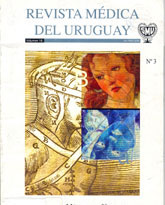Impact of the "Plan de Invierno" strategy and the use of medicines in the Paediatric Hospital at the Centro Hospitalario Pereira Rossell (CHPR)
Keywords:
DRUG COSTS, COSTS CONTROL, USE OF MEDICINES, QUALITY OF HEALTH CARE, PEDIATRIC HOSPITALSAbstract
Introduction: A strategy called Plan de Invierno was developed between May and September of 1999 in order to improve the attention at the Centro Hospitalario Pereira Rossell on children affected by low respiratory tract infections.
Objective: To evaluate the impact of this strategy on the spending related to the purchase of antibiotics (ATB), bronchodilators (2agonists) and corticosteroids in the Paediatric Hospital.
Methods: Numbers of consumed units and money spent on ATB, (2agonistas) and corticosteroids were compared during the periods of January to September of 1998 and January to September of 1999. Data were obtained from the hospital clinical pharmacy.
Results: During the period January - September of 1999, the spending was lower than during the period January - September 1998 (28.6% and 37.6% respectively). Spending on ATB and corticosteroids diminished in the general paediatric service (GP) and in the intensive paediatric care unit (UCIN). Spending related to ?2 agonists diminished only at the UCIN. Bed/day spending (DCO) on ATB decreased at the GP but was increased at the UCIN.
Conclusions: Following of the recommended therapeutic guidelines and the improvement of quality of diagnoses performed during the period of this assistance strategy probably contributed to reduce ATB, ?2 agonists, and expenses.
References
2) van Houten MA, Laseur M, Kimpen JL. Shift in antibiotic prescribing patterns in relation to antibiotic expenditure in paediatrics. Eur J Pediatr 1998; 157(6): 479-81.
3) Capellá D, Laporte JR. Métodos aplicados en estudios descriptivos de utilización de medicamentos. In: Laporte JR, Tognoni G. Principios de epidemiología del medicamento. 2ª ed. Barcelona: Masson-Salvat, 1993: 67-93.
4) Chaves A. Estudios de utilización de medicamentos: conceptos. In: Zepeda Bermudes J, De Alcántara Bonfim J. Medicamentos e a reforma do setor saúde. São Paulo: Hucitec, 1999: 101-10.
5) Chaves A. Estudios de utilización de medicamentos: aplicaciones. In: Zepeda Bermudes J, De Alcántara Bonfim J. Medicamentos e a reforma do setor saúde. São Paulo: Hucitec, 1999: 111-24.
6) Sacristan JA, Soto J. Drug utilisation studies as tools in health economics. Pharmacoeconomics 1994; 5(4): 299-312.
7) Perlstein PH, Kotagal UR, Bolling C, Steele R, Schoettker PJ, Atherton HD, et al. Evaluation of an evidence- based guideline for bronchiolitis. Pediatrics 1999; 104 (6): 1334-41.
8) Hayman JN, Crane VS. Multidisciplinary task force for controlling drug expenses. Am J Hosp Pharm 1993; 50 (11): 2343-7.












